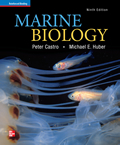1 A) 50% B) 71% C) 85% D) 25% 2 A) The Pacific B) The Arctic C) The Atlantic D) The Indian 3 A) Its area is equal to that of the Indian Ocean. B) It contains the deepest trench. C) It is geologically the newest ocean. D) It contains island arcs. 4 A) All continents once were joined into one supercontinent. B) Magnetic anomalies show that the sea floor did not form all at once. C) The oceanic lithosphere is created by sea-floor spreading. D) Sea levels dropped during the Ice Ages 5 A) New volcanic rock pushes them away from spreading centers. B) Cooling lithosphere becomes dense, sinks, and pulls a plate with it which produces "slab pull". C) Plates crack along fault lines. D) The mantle is fluid and carries plates along with it 6 A) 1,000 times surface pressure, 10,000°C B) 10,000 times surface pressure, 8,000°C C) 100,000 surface pressure, 6,000°C D) 1,000,000 surface pressure, 4,000°C 7 A) Sea floor spreading B) Movement of the crust C) Currents carrying iron from the core to the crust D) Movement of the outer core 8 A) Bacteria lived in the ocean floor millions of years ago B) Volcanoes form new rock at the ocean ridges. C) The sea floor came from the outer core D) Granite is denser than basalt 9 A) At hydrothermal vents B) Near trenches C) On top of mid-ocean ridges D) Near volcanoes 10 A) Steep ridges B) Deep trenches C) Canyons D) Lots of sediments 11 A) Siliceous ooze B) Loess deposits C) Manganese nodules D) Red clay 12 A) The continental shelf. B) The continental slope. C) The trenches. D) The continental rise. E) The abyssal plain. 13 A) True B) False 14 A) oceanic-oceanic B) continent-continent C) continental-oceanic 15 A) An oceanic-oceanic plate collision. B) An island-arc formation C) A continent-continent collision. D) A shear boundary. 16 A) Atlantic B) Pacific C) Indian D) Arctic 17 A) It gave rise to the Arctic Ocean. B) It formed between North and South America. C) Today, it is located on the eastern coast of Asia. D) It was home to may shallow-water organisms and was the precursor to today's Mediterranean Sea. 18 A) They always are cut off from the main ocean basins. B) They can contain the greatest average depths. C) They form a continuous body of water around Antarctica. D) They are shallower than the oceans. 19 A) Active Margins B) Black Smokers C) Passive Margins D) Abyssal Hills 20 A) True B) False 21 A) Microfossils B) Red Clay C) Sulfide compounds D) Radioisotopes 22 A) Similar rock formations on either side of oceans B) Similar fossils on either side of oceans C) Signs of rising sea levels D) Bands of magnetic anomalies along mid-ocean ridges.





